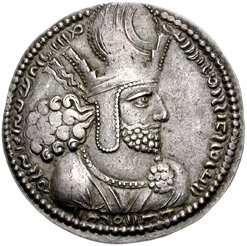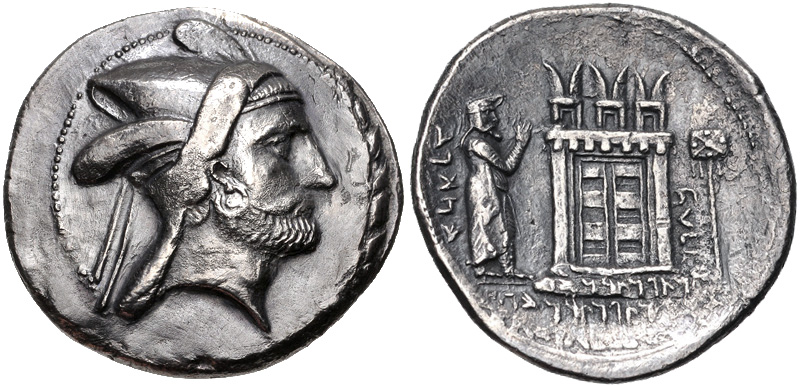|
Sasan
Sasan (Middle Persian 𐭮𐭠𐭮𐭠𐭭 ''Sāsān'' > Persian ساسان), considered the eponymous ancestor of the Sasanian (or Sassanid) Dynasty (ruled 224–651) in Persia, was "a great warrior and hunter" and a Zoroastrian high priest in Pars. He lived sometime near the fall of the Arsacid (Parthian) Empire in the early 3rd century. Identity of Sasan Medieval sources There are many slightly different stories concerning Sasan and his relation to Ardashir I, the founder of the Sasanian Empire. The northern Iranian historian Tabari mentions that Sasan married Rambehesht, a princess of the Bāzarangid family, the vassal dynasty of Pārs, and that Sasan was a grandfather of Ardashir I, while Papak is named as Ardashir I's father. According to the Pahlavi book of Karnamak-i Artaxshir-i Papakan, Sasan's wife was a daughter of a nobleman called Papak. The marriage was arranged by Papak after hearing that Sasan has " Achamenian (Achaemenid) blood in him". Their son wa ... [...More Info...] [...Related Items...] OR: [Wikipedia] [Google] [Baidu] |
Sasanian Empire
The Sasanian Empire (), officially Eranshahr ( , "Empire of the Iranian peoples, Iranians"), was an List of monarchs of Iran, Iranian empire that was founded and ruled by the House of Sasan from 224 to 651. Enduring for over four centuries, the length of the Sasanian dynasty's reign over ancient Iran was second only to the directly preceding Arsacid dynasty of Parthia. Founded by Ardashir I, whose rise coincided with the decline of Arsacid influence in the face of both internal and external strife, the House of Sasan was highly determined to restore the legacy of the Achaemenid Empire by expanding and consolidating the Iranian nation's dominions. Most notably, after defeating Artabanus IV of Parthia during the Battle of Hormozdgan in 224, it began competing far more zealously with the neighbouring Roman Empire than the Arsacids had, thus sparking a new phase of the Roman–Iranian Wars. This effort by Ardashir's dynasty ultimately re-established Iran as a major power of late an ... [...More Info...] [...Related Items...] OR: [Wikipedia] [Google] [Baidu] |
Ardashir I
Ardashir I (), also known as Ardashir the Unifier (180–242 AD), was the founder of the Sasanian Empire, the last empire of ancient Iran. He was also Ardashir V of the Kings of Persis, until he founded the new empire. After defeating the last Parthian Empire, Parthian King of Kings, shahanshah Artabanus IV of Parthia, Artabanus IV on the Battle of Hormozdgan, Hormozdgan plain in 224, he overthrew the Parthian Empire, Arsacid dynasty and established the Sasanian dynasty. Afterwards, Ardashir called himself ''shahanshah'' and began conquering the land that he called ''Iran (word), Eranshahr'', the realm of the Arya (Iran), Iranians. There are various historical reports about Ardashir's lineage and ancestry. According to al-Tabari's ''History of the Prophets and Kings'', Ardashir was son of Papak, son of Sasan. Another narrative recorded in Kar-Namag i Ardashir i Pabagan, ''Kar-Namag i Ardashir i Pabagan'' and Ferdowsi, Ferdowsi's ''Shahnameh'' states that Ardashir was born from the ... [...More Info...] [...Related Items...] OR: [Wikipedia] [Google] [Baidu] |
List Of Shahanshahs Of The Sasanian Empire
The House of Sasan, Sasanian monarchs were the rulers of Iran after their victory against their former suzerain, the Parthian Empire, at the Battle of Hormozdgan in 224. At its height, the Sasanian Empire spanned from Turkey and Rhodes in the west to Pakistan in the east, and also included territory in what is now the Caucasus, Yemen, UAE, Oman, Egypt, Palestine, Israel, Lebanon, Syria, Jordan and Central Asia. The Sasanian Empire was recognized as one of the main powers in the world alongside its neighboring arch rival, the Roman Empire for a period of more than 400 years.Norman A. Stillman ''The Jews of Arab Lands'' pp 22 Jewish Publication Society, 1979 International Congress of Byzantine Studies ''Proceedings of the 21st International Congress of Byzantine Studies, London, 21–26 August 2006, Volumes 1-3'' pp 29. Ashgate Pub Co, 30 sep. 2006 The Sasanian dynasty began with Ardashir I in 224, who was a Persian people, Persian from Istakhr, and ended with Yazdegerd III in 651. ... [...More Info...] [...Related Items...] OR: [Wikipedia] [Google] [Baidu] |
House Of Sasan
The Sasanian dynasty (also known as the Sassanids or the House of Sasan) was the house that founded the Sasanian Empire of Iran, ruling this empire from 224 to 651 AD. It began with Ardashir I, who named the dynasty in honour of his predecessor, Sasan. The Shahanshah was the sole regent, head of state and head of government of the empire. At times, power shifted de facto to other officials, namely the spahbed. Upon the empire's conquest by the Islamic caliphate in 651, members of the imperial family fled in exile to China following the death of Yazdegerd III, where they would become accepted as members of the imperial court by Emperor Gaozong of Tang. Although there would be numerous attempts to invade Islamic Persia with Chinese support, this branch of Sasanids would remain in China indefinitely. Narsieh, grandson of Yazdegerd and last recorded Sasanid in China, would adopt the surname Li (李) in honor of the Chinese imperial family. Origins Modern Scholars View The ori ... [...More Info...] [...Related Items...] OR: [Wikipedia] [Google] [Baidu] |
Papak
Pabag (, ''Pāpak/Pābag''; New Persian: ''Bābak'') was an Iranian prince who ruled Istakhr, the capital of Pars, from 205 or 206 until his death sometime between 207 and 210. He was the father, stepfather, grandfather, or father-in-law of Ardashir I, the founder of the Sasanian Empire. He was succeeded by his eldest son, Shapur. Background and state of Pars Pars (also known as Persis), a region in the southwestern Iranian plateau, was the homeland of a southwestern branch of the Iranian people, the Persians. It was also the birthplace of the first Iranian Empire, the Achaemenids. The region served as the center of the empire until its conquest by the Macedonian king Alexander the Great (). Since the end of the 3rd or the beginning of the 2nd century BCE, Pars has been ruled by local dynasties subject to the Hellenistic Seleucid Empire. These dynasts held the ancient Persian title of '' frataraka'' ("leader, governor, forerunner"), which is also attested in the Acha ... [...More Info...] [...Related Items...] OR: [Wikipedia] [Google] [Baidu] |
Touraj Daryaee
Touraj Daryaee (; 20 July, 1967) is an Iranian Iranologist and historian. He currently works as the Maseeh Chair in Persian Studies and Culture and the director of the Dr. Samuel M. Jordan Center for Persian Studies at the University of California, Irvine. Career Daryaee completed his elementary and secondary schooling in Tehran, Iran and Athens, Greece. He then completed a PhD in history at the University of California, Los Angeles in 1999. He has taught at UCLA, and has been a senior research fellow at Oxford University and resident fellow at the École pratique des hautes études. He specializes in the history and culture of Ancient Persia. He is the editor of the ''Name-ye Iran-e Bastan'', ''The International Journal of Ancient Iranian Studies'', ''DABIR: Digital Ar'', as well as the director of ''Sasanika Project'', a project on the history and culture of Sasanians. His most famous publications include ''Sasanian Persia: The Rise and Fall of an Empire'' and ''Sasanian Iran ... [...More Info...] [...Related Items...] OR: [Wikipedia] [Google] [Baidu] |
Estakhr
Istakhr (Middle Persian romanized: ''Stakhr'', ) was an ancient city in Fars province, north of Persepolis in southwestern Iran. It flourished as the capital of the Persian '' Frataraka'' governors and Kings of Persis from the third century BC to the early 3rd century AD. It reached its apex under the Sasanian Empire (224-651 AD), and was the hometown of the Sasanian dynasty. Istakhr briefly served as the first capital of the Sasanian Empire from 224 to 226 AD and then as principal city, region, and religious centre of the Sasanian province of Pars. During the Arab conquest of Iran, Istakhr was noted for its stiff resistance, which resulted in the death of many of its inhabitants. Istakhr remained a stronghold of Zoroastrianism long after the conquests, and remained relatively important in the early Islamic era. It went into gradual decline after the founding of nearby Shiraz, before being destroyed and abandoned under the Buyids. Cursorily explored by Ernst Herzfeld and a te ... [...More Info...] [...Related Items...] OR: [Wikipedia] [Google] [Baidu] |
Parthian Empire
The Parthian Empire (), also known as the Arsacid Empire (), was a major Iranian political and cultural power centered in ancient Iran from 247 BC to 224 AD. Its latter name comes from its founder, Arsaces I, who led the Parni tribe in conquering the region of Parthia in Iran's northeast, then a satrapy (province) under Andragoras, who was rebelling against the Seleucid Empire. Mithridates I ( BC) greatly expanded the empire by seizing Media and Mesopotamia from the Seleucids. At its height, the Parthian Empire stretched from the northern reaches of the Euphrates, in what is now central-eastern Turkey, to present-day Afghanistan and western Pakistan. The empire, located on the Silk Road trade route between the Roman Empire in the Mediterranean Basin and the Han dynasty of China, became a center of trade and commerce. The Parthians largely adopted the art, architecture, religious beliefs, and regalia of their culturally heterogeneous empire, which encompassed Pe ... [...More Info...] [...Related Items...] OR: [Wikipedia] [Google] [Baidu] |
Iran
Iran, officially the Islamic Republic of Iran (IRI) and also known as Persia, is a country in West Asia. It borders Iraq to the west, Turkey, Azerbaijan, and Armenia to the northwest, the Caspian Sea to the north, Turkmenistan to the northeast, Afghanistan to the east, Pakistan to the southeast, and the Gulf of Oman and the Persian Gulf to the south. With a Ethnicities in Iran, multi-ethnic population of over 92 million in an area of , Iran ranks 17th globally in both List of countries and dependencies by area, geographic size and List of countries and dependencies by population, population. It is the List of Asian countries by area, sixth-largest country entirely in Asia and one of the world's List of mountains in Iran, most mountainous countries. Officially an Islamic republic, Iran is divided into Regions of Iran, five regions with Provinces of Iran, 31 provinces. Tehran is the nation's Capital city, capital, List of cities in Iran by province, largest city and financial ... [...More Info...] [...Related Items...] OR: [Wikipedia] [Google] [Baidu] |
Ka'ba-ye Zartosht
Kaaba, Ka'ba-ye Zartosht (), also called the Kaaba or Cube of Zoroaster, is a rectangular stepped stone structure in the Naqsh-e Rustam compound beside Zangiabad, Fars, Zangiabad village in Marvdasht county in Fars province, Fars, Iran. The Naqsh-e Rustam compound also incorporates memorials of the Elamites, the Achaemenid Empire, Achaemenids and the Sasanian Empire, Sasanians. Architecturally, it is one of several Kaabas. The Ka'ba-ye Zartosht is from the mountain, situated exactly opposite Darius II's mausoleum. It is rectangular and has only one entrance door. The material of the structure is white limestone. It is about high, or if including the triple stairs, and each side of its base is about long. Its entrance door leads to the chamber inside via a thirty-stair stone stairway. The stone pieces are rectangular and are simply placed on top of each other, without the use of Mortar (masonry), mortar; the sizes of the stones varies from to , and they are connected to each ... [...More Info...] [...Related Items...] OR: [Wikipedia] [Google] [Baidu] |



